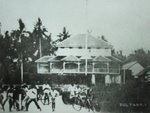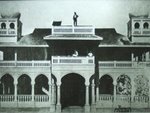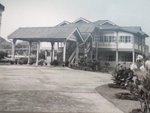The Oxford Business Group reported on 2nd December 2010 the following news:
Brunei: Stronger Links
The 17th ASEAN summit in Hanoi in October saw Brunei Darussalam taking steps to improve economic ties with several of its partners in the 10-member organisation, as well as with non-member states. The summit, the second held under Vietnam’s chairmanship, came at a crucial time for ASEAN as it seeks to build more internal economic integration while also strengthening its geostrategic role.
Compared with other ASEAN nations, Brunei Darussalam is relatively small, both in terms of size and population. As ASEAN is a key forum for articulation of the smaller nations’ views and interests, strengthening ties with the organisation has long been one of the Sultanate’s key foreign policy objectives. Indeed, the summit provided an opportunity for Brunei Darussalam to reinforce its ties with its neighbours while strengthening relations with other regional powers.
On October 28 His Majesty Sultan Hassanal Bolkiah met with Nguyen Tan Dung, the Vietnamese prime minister, who proposed that an investment protection agreement and memorandum of understanding (MoU) on fisheries between the two countries should be signed. His Majesty Bolkiah also proposed further cooperation in fisheries, trade, investment and agriculture, with the Vietnamese stating on the latter point that they were ready to export rice to Brunei Darussalam.
Agriculture was also top of the agenda in discussions between the Bruneian leader and the Philippines President Benigno Aquino III. According to the chief Filipino presidential spokesperson, a broad discussion on agricultural issues took place between the two leaders, with this likely to be the first step toward a bilateral agreement that would supply Filipino foodstuffs to the Sultanate.
The focus for these potential future imports was the southern Filipino island of Mindanao, which is part of the Brunei-Indonesia-Malaysia-Philippines East ASEAN Growth Area (BIMPEAGA). The potential for the island as a future hub for halal food production was raised by the Sultan, according to the Filipinos, with the proviso that this objective would likely be realised after a lasting peace settlement on the troubled island.
Brunei has had a strong commitment to the peace process on the island for some time, sending a contingent from the Royal Brunei Armed Forces as part of the peace monitoring effort. There has been a decades long conflict there between the Filipino government and the Moro Islamic Liberation Front over autonomy and human rights.
Brunei also sent a representative from the Brunei Investment Authority to the upcoming public-private-partnership conference being held in Manila later in November. The conference aims to drum up more foreign investment for the Philippines.
In addition to relations with its immediate neighbours, Brunei has also been keen to strengthen ties with other important countries in the region. In this regard His Majesty also praised ASEAN’s relationship with Australia and New Zealand at the ASEAN summit and at the associated ASEAN-Australia summit, which was attended by newly elected Australian Prime Minister Julia Gillard. He also highlighted the importance of ASEAN’s links with Russia at the ASEAN-Russian summit, which was held during the time of the meeting in Hanoi. Russian President Dimitry Medvedev attended this meeting, where the Sultan welcomed Russia’s inclusion in the East Asia Summit (EAS) and the ASEAN 10+8 defence ministers’ meeting.
The EAS, which met during the ASEAN summit, also saw the participation of the US for the first time, while the meeting of ASEAN+ 3 (Japan, South Korea and China) also took place. India was also present in Hanoi, pursuing its new “Look East” policy at the eighth ASEAN-India summit, an event which saw a further strengthening of trade links and which promises the establishment of a free trade agreement (FTA) after 2016.
Brunei Darussalam supports an inclusive series of agreements and dialogues between ASEAN and other regional players, seeing these as ways to strengthen both prosperity and political stability. The FTAs are expected to boost trade levels and the need to focus on comparative advantage will be more pressing than ever when they take full effect. The Sultanate’s decision to move toward more value-added industries is likely to be an increasingly necessary strategy if Brunei is to benefit from more open trade with mass manufacturing economies. Welcoming in all the neighbours may give the Sultanate a chance to show its unique qualities to an ever-wider world.
“We should further undertake comprehensive measures to ensure ASEAN centrality in an evolving regional architecture,” Vietnamese premier Nguyen said at the opening of the summit, addressing a key underlying concern of many member states. Vietnam had held the rotating chair of ASEAN this year, with this position handed over to Indonesia at the end of the summit.
The architecture the prime minister was talking about is not evolving in a vacuum, but within the context of growing interest in the region from outside, notably from China. Other powers, such as the US, India and Russia, all have interests and initiatives under way in South-east Asia. Moving forward, Brunei Darussalam looks set to continue on a path of increasing cooperation with states both within and outside of the ASEAN region.
Welcome to my private journal generally on Brunei issues. Any opinions expressed are in my personal capacity. All rights to the articles are reserved.
Friday, December 3, 2010
Monday, November 1, 2010
Time Traveler?

I was very intrigued when I read a news article about a film-maker believes he has found evidence of time travel in footage from a Charlie Chaplin film premiere shot in 1928. You can go to youtube or the still as above.
George Clarke, from Belfast, says he has been puzzled for more than a year by the film which appears to show a woman talking on a mobile phone. He has posted the video on YouTube where it has notched up more than 2.2 million hits in just ten days, reports the BBC. Mr Clarke was checking the extras on a Chaplin DVD box-set and began watching a clip of the 1928 Hollywood premiere of The Circus.
"As I sat back to watch it I realised in the first 30 seconds there's a lady strolling by with her hand up to her ear which looked quite familiar in today's society," he said.
"So I wound it back and watched it again, zoomed it in and slowed it down and got other people in to check it out. Everybody had the same reaction - it looks like she's talking on a mobile phone."
He has since showed the clip to a number of people, including the audience of a Belfast film festival but says no-one has been able to provide an explanation. Since posting it on Youtube, the clip has provoked nearly 18,000 comments, divided between those who believe in the possibility of time travel, and that someone also pointed out that this is not an uncommon item in 1920s.
A quick check at Siemens website that in 1924, Siemens had a patent for a compact, pocket size carbon microphone and the photograph of a middle aged man holding which looked like a mobile phone in 1924 which looked like this:-

According to the Siemens website, for a while, the carbon amplifier patented by Siemens played a major role in hearing aid technology and significantly raised the volume of hearing aids.
The electrical energy controlled by the carbon microphone was not fed to the receiver directly. It first drove the diaphragm of an electromagnetic system connected to a carbon-granule chamber. Current was transmitted across this chamber from the vibrating diaphragm electrode to the fixed electrode plate.
The amplified current produced mechanical vibrations in the electromagnetic hearing diaphragm that were then transmitted to the ear as sound.

According to the Siemens website, for a while, the carbon amplifier patented by Siemens played a major role in hearing aid technology and significantly raised the volume of hearing aids.
The electrical energy controlled by the carbon microphone was not fed to the receiver directly. It first drove the diaphragm of an electromagnetic system connected to a carbon-granule chamber. Current was transmitted across this chamber from the vibrating diaphragm electrode to the fixed electrode plate.
The amplified current produced mechanical vibrations in the electromagnetic hearing diaphragm that were then transmitted to the ear as sound.
Which do you believe?
Sunday, October 31, 2010
BEDB Houses at Pandan, Kuala Belait
Yesterday was our second MOD visit to Kampong Pandan to visit the 2,000 houses that BEDB is currently building for us. Sometime last year, we visited them with the former Minister and at that time, other than a few sample houses, most of the houses were in various stages of completion. Unlike yesterday, it is the other way around, most of the houses are nearly completed.
We even visited the inside of the houses where two of the houses were actually fully furnished.

Complete with proper interior decoration and nice furniture, I thought the houses looked very nice. Altogether there are 2,000 houses being built. Currently around 1,700+ houses have been completed and there should be another 200+ houses left to be completed. There will be 800 semi detached houses of around 1,300 square feet area and 1,200 terrace houses of around 1,200 square feet area. The colour schemes for the interior of the house is very nice. Our own officers even want to take photographs inside the house.

How about the outside?

I have to admit it does look plain and simple despite the grand colours. First timers might find themselves lost as the houses are not differentiated. The houses are divided into 6 precincts with each precinct having aound 200 to 400 houses. The semi-detached houses are grouped together with the entrance from the highway whereas the terrace houses can easily be found by using the entrance from Jalan Singa Menteri.
Any other caveats? None as far as I can see, except that people living in the houses have to realise that their sidewalls are cement and not bricks. The brick walls areas are where you can put the aircond.
We even visited the inside of the houses where two of the houses were actually fully furnished.

Complete with proper interior decoration and nice furniture, I thought the houses looked very nice. Altogether there are 2,000 houses being built. Currently around 1,700+ houses have been completed and there should be another 200+ houses left to be completed. There will be 800 semi detached houses of around 1,300 square feet area and 1,200 terrace houses of around 1,200 square feet area. The colour schemes for the interior of the house is very nice. Our own officers even want to take photographs inside the house.

How about the outside?

I have to admit it does look plain and simple despite the grand colours. First timers might find themselves lost as the houses are not differentiated. The houses are divided into 6 precincts with each precinct having aound 200 to 400 houses. The semi-detached houses are grouped together with the entrance from the highway whereas the terrace houses can easily be found by using the entrance from Jalan Singa Menteri.
Any other caveats? None as far as I can see, except that people living in the houses have to realise that their sidewalls are cement and not bricks. The brick walls areas are where you can put the aircond.
Saturday, October 30, 2010
Value of Brunei's Undistributed Stamps

I was really surprised to see this set of stamps. This set of stamps was supposed to be released in 1970 but it was never released. The stamps were supposed to have been destroyed but I guess with these sets in the market, someone somewhere decided not to destroy every single one.
I came across this set sometime early this year when my dealer in Singapore showed the whole set and I paid around S$800 for the entire four stamps. When I told one of my friends in Brunei who specialised in antiques, he said I overpaid for it. It's difficult to estimate what the value is as these stamps do not come up for auctions that often.
When I saw it on ebay, I was surprised and put up a bid for it. I was the highest at one stage but towards the end, there were just too many bidders, serious ones too. When the dust cleared, the stamps were sold for US$935 which is even way way what I paid for. Whoever bought it, congratulations, I do hope no more of these stamps will appear suddenly any more.
Tuesday, October 26, 2010
Stopover with Majesty
[This article was published in Australia's Sydney Morning Herald on 24 October 2010]
Steve McKenna swings from royalty to rainforest in one of south-east Asia's most underrated destinations.
MY HEART is beating faster than normal as I approach the Sultan of Brunei. We're in the lavish surrounds of his 1788-room palace, standing beneath a ceiling coated in crystal and, although it feels like a dream, I don't have time to pinch myself.
Smiling and looking genuinely pleased to see me, his majesty shakes my hand. It's neither a wet fish nor a bone cruncher. It's just right, in fact, though I'm not surprised by his expertise, considering the amount of practise he gets.
Advertisement: Story continues below
The sultan will greet about 50,000 people in the course of the weekend as part of the celebrations for Hari Raya, an annual festival that follows the Muslim fasting month of Ramadan. For three days, Bruneians and foreigners can visit the palace, where a buffet bulging with treats is laid on, compliments of his majesty.
Bellies full, men then queue to meet the sultan and male members of the Bruneian royal family (including eccentric playboy Prince Jefri). Women are shepherded to another opulent room, where the queen and princesses await. Later, everyone leaves with a gift. This year, it's cake.
A sovereign state swimming in oil on the north coast of the island of Borneo, Brunei boasts far more than just regal splendour and black gold (more than 1 billion barrels' worth of oil has been pumped out since the resource was first tapped in 1929).
In four days, I'm won over by the country's jewels: tropical jungles teeming with wildlife, atmospheric villages, sublime Islamic-influenced architecture, delicious, spicy Malaysian-style cuisine and friendly people - many of whom speak fluent English as well as Malay, the official language.
Brunei was a British protectorate from 1888 to 1984 and still bears a few influences - driving on the left-hand side, for instance. However, religion holds greater sway: Islam arrived here with Arab traders in the 14th century and the sultan is part of a dynasty that claims direct descent from the prophet Muhammad. On his watch, Friday prayers are near-sacrosanct, aspects of Sharia law are in force and alcohol is essentially banned (though foreigners can bring 12 cans of beer and two bottles of wine or spirits through customs for private use).
Yet Brunei is no fundamentalist backwater and instead lives up to its full name, Brunei Darussalam (Abode of Peace). Various religions flourish here, violent crime is virtually non-existent and Bruneinan women wear a mix of Western-style clothes and traditional Malay outfits and headscarves. Brunei's capital, Bandar Seri Begawan, is small, clean, green, low-key and laid-back. Also shorn of pesky street salesmen and choking traffic jams, it's a fine base for exploring the country.
As well as two huge, beautiful mosques and a clutch of intriguing museums, Bandar offers Kampong Ayer - a collection of "floating" villages that have huddled here, in some form, for a millennium.
Home to about 20,000 people, Kampong Ayer was mentioned in the chronicles of Antonio Pigafetta, a member of Ferdinand Magellan's 16th-century round-the-world expedition, which passed through Borneo's waters.
Treading the boardwalks linking Kampong Ayer's wooden stilt homes, workshops, schools and medical centres, I chat with locals.
Most homes have satellite dishes, while the government's oil-rich coffers means healthcare and education are free for all citizens, there's no income tax and petrol is cheap (about 30¢ a litre). Much of Brunei is covered in rainforest and on a water-taxi tour of the jungle-fringed waterways around Bandar, I spot proboscis monkeys and macaques swinging between branches and crocodiles sunbathing in mangroves.
I also venture deeper into Brunei's interior by motor boat, to Temburong, the smaller, eastern slice of Brunei. Split from Bandar, and its more populated western part by Malaysia's state of Sarawak, Temburong is home to Ulu Ulu, a rainforest eco-resort where you relax to the sounds of chirping crickets and cicadas, or tackle a raft of jungle-based adventures. Early next morning, I'm woken by a guide and embark on a sweaty, humid 30-minute trek to a vantage point overlooking the misty rainforest canopy. The prize is seeing a magical, almost ethereal, Borneo sunrise. My last night in Brunei is spent at the sumptuous Empire Hotel and Country Club, said to be a favourite hang-out of the sultan, his polo-playing friend Prince Charles and Bill Clinton. Built a decade ago on the fringes of the South China Sea for a reported $1.1 billion, the club is a riot of Italian marble, gilded columns and shimmering chandeliers, with a spa, pools and a Jack Nicklaus-designed golf course.
As I enjoy a glass of red on my balcony, I toast Brunei. Australians are spoilt for choice when it comes to stopovers in Asia and although the sultanate lacks the fame of Hong Kong or Singapore, the country is every bit as rewarding.
The writer was a guest of Royal Brunei Airlines.
Trip notes
Getting there
Royal Brunei flies from Brisbane to Brunei priced from $620 return, with connections to other Asian cities and London (alcohol-free flights). (07) 3860 6700, bruneiair.com.
Staying there
Radisson Hotel in Bandar has double rooms priced from $Br165 ($130) a night. +673 224 4272, www.radisson.com/brunei. Empire Hotel and Country Club rooms are from about $Br400 a night. + 673 241 8888, theempirehotel.com. A night at Ulu Ulu Resort, including transfers, activities and meals, is from $Br350 a person, twin share. + 673 244 1791, uluuluresort.com.
Steve McKenna swings from royalty to rainforest in one of south-east Asia's most underrated destinations.
MY HEART is beating faster than normal as I approach the Sultan of Brunei. We're in the lavish surrounds of his 1788-room palace, standing beneath a ceiling coated in crystal and, although it feels like a dream, I don't have time to pinch myself.
Smiling and looking genuinely pleased to see me, his majesty shakes my hand. It's neither a wet fish nor a bone cruncher. It's just right, in fact, though I'm not surprised by his expertise, considering the amount of practise he gets.
Advertisement: Story continues below
The sultan will greet about 50,000 people in the course of the weekend as part of the celebrations for Hari Raya, an annual festival that follows the Muslim fasting month of Ramadan. For three days, Bruneians and foreigners can visit the palace, where a buffet bulging with treats is laid on, compliments of his majesty.
Bellies full, men then queue to meet the sultan and male members of the Bruneian royal family (including eccentric playboy Prince Jefri). Women are shepherded to another opulent room, where the queen and princesses await. Later, everyone leaves with a gift. This year, it's cake.
A sovereign state swimming in oil on the north coast of the island of Borneo, Brunei boasts far more than just regal splendour and black gold (more than 1 billion barrels' worth of oil has been pumped out since the resource was first tapped in 1929).
In four days, I'm won over by the country's jewels: tropical jungles teeming with wildlife, atmospheric villages, sublime Islamic-influenced architecture, delicious, spicy Malaysian-style cuisine and friendly people - many of whom speak fluent English as well as Malay, the official language.
Brunei was a British protectorate from 1888 to 1984 and still bears a few influences - driving on the left-hand side, for instance. However, religion holds greater sway: Islam arrived here with Arab traders in the 14th century and the sultan is part of a dynasty that claims direct descent from the prophet Muhammad. On his watch, Friday prayers are near-sacrosanct, aspects of Sharia law are in force and alcohol is essentially banned (though foreigners can bring 12 cans of beer and two bottles of wine or spirits through customs for private use).
Yet Brunei is no fundamentalist backwater and instead lives up to its full name, Brunei Darussalam (Abode of Peace). Various religions flourish here, violent crime is virtually non-existent and Bruneinan women wear a mix of Western-style clothes and traditional Malay outfits and headscarves. Brunei's capital, Bandar Seri Begawan, is small, clean, green, low-key and laid-back. Also shorn of pesky street salesmen and choking traffic jams, it's a fine base for exploring the country.
As well as two huge, beautiful mosques and a clutch of intriguing museums, Bandar offers Kampong Ayer - a collection of "floating" villages that have huddled here, in some form, for a millennium.
Home to about 20,000 people, Kampong Ayer was mentioned in the chronicles of Antonio Pigafetta, a member of Ferdinand Magellan's 16th-century round-the-world expedition, which passed through Borneo's waters.
Treading the boardwalks linking Kampong Ayer's wooden stilt homes, workshops, schools and medical centres, I chat with locals.
Most homes have satellite dishes, while the government's oil-rich coffers means healthcare and education are free for all citizens, there's no income tax and petrol is cheap (about 30¢ a litre). Much of Brunei is covered in rainforest and on a water-taxi tour of the jungle-fringed waterways around Bandar, I spot proboscis monkeys and macaques swinging between branches and crocodiles sunbathing in mangroves.
I also venture deeper into Brunei's interior by motor boat, to Temburong, the smaller, eastern slice of Brunei. Split from Bandar, and its more populated western part by Malaysia's state of Sarawak, Temburong is home to Ulu Ulu, a rainforest eco-resort where you relax to the sounds of chirping crickets and cicadas, or tackle a raft of jungle-based adventures. Early next morning, I'm woken by a guide and embark on a sweaty, humid 30-minute trek to a vantage point overlooking the misty rainforest canopy. The prize is seeing a magical, almost ethereal, Borneo sunrise. My last night in Brunei is spent at the sumptuous Empire Hotel and Country Club, said to be a favourite hang-out of the sultan, his polo-playing friend Prince Charles and Bill Clinton. Built a decade ago on the fringes of the South China Sea for a reported $1.1 billion, the club is a riot of Italian marble, gilded columns and shimmering chandeliers, with a spa, pools and a Jack Nicklaus-designed golf course.
As I enjoy a glass of red on my balcony, I toast Brunei. Australians are spoilt for choice when it comes to stopovers in Asia and although the sultanate lacks the fame of Hong Kong or Singapore, the country is every bit as rewarding.
The writer was a guest of Royal Brunei Airlines.
Trip notes
Getting there
Royal Brunei flies from Brisbane to Brunei priced from $620 return, with connections to other Asian cities and London (alcohol-free flights). (07) 3860 6700, bruneiair.com.
Staying there
Radisson Hotel in Bandar has double rooms priced from $Br165 ($130) a night. +673 224 4272, www.radisson.com/brunei. Empire Hotel and Country Club rooms are from about $Br400 a night. + 673 241 8888, theempirehotel.com. A night at Ulu Ulu Resort, including transfers, activities and meals, is from $Br350 a person, twin share. + 673 244 1791, uluuluresort.com.
Subscribe to:
Posts (Atom)











